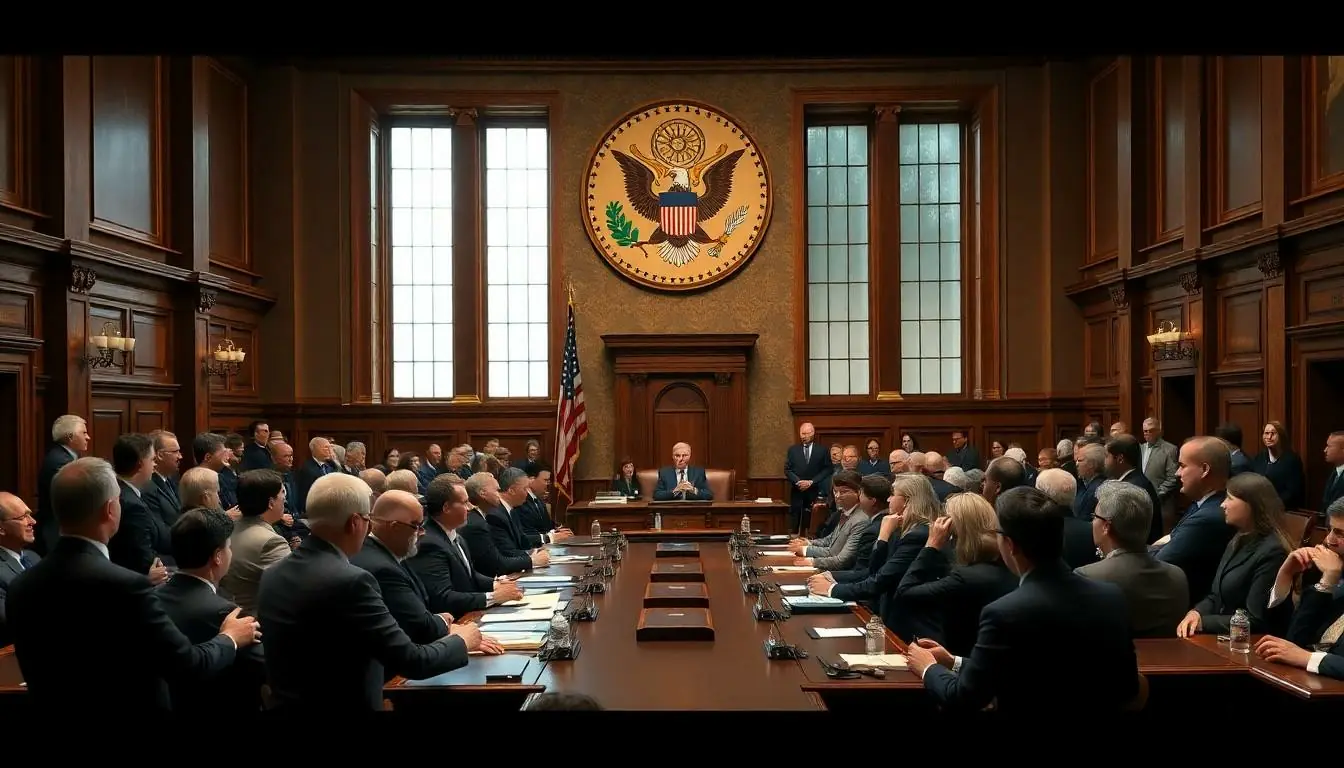Government and public administration might sound like a dry topic, but it’s the backbone of society—like the unsung hero of a superhero movie, always working behind the scenes. From crafting policies that keep the lights on to ensuring that the potholes finally get fixed, public administration is where the magic happens.
Table of Contents
ToggleOverview of Government and Public Administration
Government and public administration encompass the processes and structures responsible for organizing and directing public resources. Leadership in government involves various entities that develop and implement policies impacting citizens’ daily lives. Public administrators ensure that essential services, such as healthcare and education, are accessible and efficiently managed.
Legislation lays the groundwork for public policies, establishing rules and regulations that shape societal norms. Government agencies, ranging from local to federal levels, operate within these frameworks to execute programs and initiatives. Public finance plays a crucial role in budgeting, allocating funds to priorities like infrastructure, healthcare, and social services.
Accountability in government enhances transparency, allowing citizens to monitor administrative actions. Heavily influenced by public opinion, policymakers strive to balance the needs of constituents with available resources. Data collection and analysis guide decision-making, providing insights into community needs and service effectiveness.
Collaboration among stakeholders contributes significantly to successful governance. Non-governmental organizations (NGOs), private sectors, and community groups work together with public institutions to tackle complex issues. Grant programs and public-private partnerships exemplify how shared goals can foster innovative solutions.
Global trends also affect government and public administration. Technological advancements and globalization introduce new challenges and opportunities for public managers. Adaptive strategies ensure that administrations respond effectively to evolving societal demands.
Government and public administration function as vital components in maintaining societal order. These systems enable resource allocation, policy development, and service delivery essential for community well-being.
Key Components of Government

Government consists of three primary branches: legislative, executive, and judicial. These branches work together to create and enforce laws, ultimately influencing the daily lives of citizens.
Legislative Branch
Legislation is crucial for establishing rules and regulations. The legislative branch, often referred to as Congress, consists of two chambers: the House of Representatives and the Senate. Each chamber has distinct responsibilities, with representatives focused on local interests and senators addressing broader state concerns. Legislators craft bills that can transform societal norms, ensuring responsive governance. Public participation often shapes the legislative process, as constituents voice their needs. Essential functions include reviewing budgets, overseeing government actions, and conducting hearings to hold executive officials accountable.
Executive Branch
The executive branch carries out laws and administers government operations. Headed by the President, this branch includes Vice Presidents, Cabinet members, and numerous federal agencies. Each agency specializes in specific areas, such as healthcare or education, playing a role in policy implementation. Executives set priorities through budget allocations and strategic planning, ensuring resources align with public needs. Leadership emphasizes collaboration with state and local governments to foster efficiency. This branch also addresses urgent issues, responding to natural disasters and public health emergencies proactively.
Judicial Branch
The judicial branch interprets laws and ensures justice. Courts operate at various levels, from local to Supreme Court, providing a structure for legal disputes. Judges help maintain the rule of law, applying legal principles to cases that affect citizens. The judiciary also plays a vital role in protecting rights, reviewing legislative and executive actions for constitutionality. Through judicial review, the courts can overturn laws that conflict with constitutional protections. This system of checks and balances reinforces democracy, ensuring no branch oversteps its authority.
Public Administration Fundamentals
Public administration serves as the backbone of a well-functioning government. It encompasses the organization, implementation, and management of public policies to ensure societal needs are met.
Definition and Scope
Public administration refers to the processes and institutions that govern public policy implementation. This field covers a broad spectrum, including local, state, and federal levels of government. Responsibilities include managing public resources, establishing regulations, and delivering services to citizens. It also involves coordinating various government agencies, each with specific duties aimed at enhancing public welfare. Focus centers on both strategic planning and daily operations to address complex challenges in society.
Importance of Public Administration
The role of public administration is critical in developing effective governance structures. It ensures public policies translate into tangible outcomes for communities. Accountability and transparency enable citizens to engage with their government, fostering trust and cooperation. A well-managed public administration promotes efficient use of resources, directing funding to essential services like healthcare and education. Collaborative efforts with stakeholders, including non-profits and private sectors, create innovative solutions for pressing social issues. Robust public administration ultimately strengthens democratic principles and enhances community resilience.
Roles and Responsibilities in Governance
Governance encompasses diverse roles and responsibilities essential for effective public administration. Elected officials and civil servants work collaboratively to implement policies that impact citizens’ lives.
Elected Officials
Elected officials represent the interests of their constituents at various government levels. Responsibilities include crafting legislation and overseeing government agencies. Members of Congress advocate for the public’s needs and establish laws guiding societal norms. Local representatives address community issues, ensuring that policies reflect constituents’ desires. Accountability is crucial, as officials must justify decisions to the public. Economic growth, education reforms, and healthcare access are examples of focal points for elected leaders. Public engagement is vital, enabling officials to understand community concerns and respond effectively.
Civil Servants
Civil servants play a key role in executing government policies and managing public resources. These professionals ensure the efficient delivery of services to citizens at local, state, and federal levels. They work on implementing laws passed by elected officials, translating legislative intent into actionable programs. Robust training prepares civil servants to handle administrative tasks, from budgeting to program evaluation. Collaboration with diverse stakeholders enhances public service delivery. Transparency and accountability in their actions foster public trust. Diverse responsibilities, including regulatory compliance and crisis management, enable civil servants to meet evolving societal needs effectively.
Challenges in Government and Public Administration
Government and public administration face various challenges that influence their effectiveness. Two significant issues are bureaucracy and red tape, along with transparency and accountability.
Bureaucracy and Red Tape
Bureaucracy often leads to slow decision-making processes. Administrative layers can complicate interactions between agencies and the public. Red tape hinders efficiency by requiring extensive documentation and compliance measures. Citizens frequently encounter delays when navigating public services due to complex regulations. Government agencies strive to streamline processes but often face resistance to change from established practices. Reform initiatives aimed at reducing excessive bureaucracy can improve service delivery and enhance public satisfaction. Successful examples demonstrate that simplified procedures lead to better citizen engagement and resource allocation.
Transparency and Accountability
Transparency is crucial for establishing trust in government operations. Citizens expect clear communication regarding policies and decisions affecting their lives. Accountability mechanisms ensure officials answer for their actions, promoting responsible governance. Public access to information can empower citizens to engage actively in democratic processes. Agencies must adopt practices that enhance transparency, such as open-data initiatives and public reporting. Enhanced accountability fosters a culture of integrity and allows for constructive criticism of public administration. Addressing transparency challenges can strengthen community trust and support collaborative governance.
Government and public administration play a pivotal role in shaping the lives of citizens and the functionality of society. By managing resources and implementing policies, they ensure essential services are accessible and effectively delivered. The collaboration between elected officials and civil servants fosters a responsive governance structure that addresses community needs.
Challenges like bureaucracy and the demand for transparency can hinder efficiency, but reform initiatives can pave the way for improved service delivery. Emphasizing accountability and public engagement strengthens the bond between citizens and their government. As global trends evolve, adaptive strategies in public administration will be crucial for meeting the dynamic needs of society. Ultimately, robust public administration not only enhances democratic values but also contributes to the resilience and well-being of communities.





